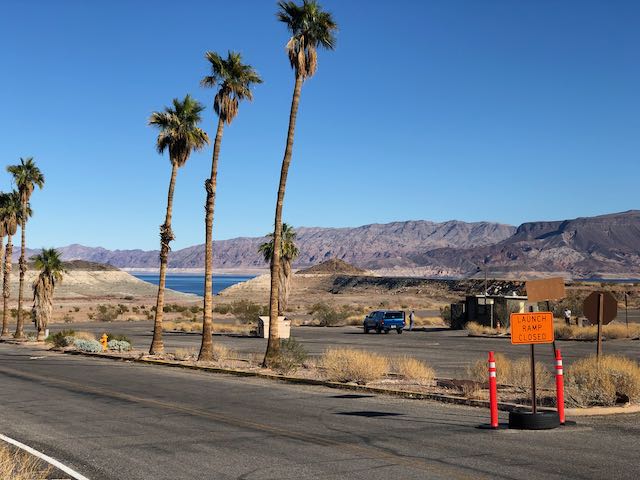
Lake Mead, December 2021, by John Fleck
In the wake of a Colorado River Water Users Association meeting that was by turns exuberant (We got to see one another for the first time since the Before Times!) and stark (The reservoirs are nearly empty!), Anne Castle and I have a new paper out this week in a special issue of the journal Water with some suggestions for what needs to happen next.
Our key bits:
- Hydrology matters. (Well duh!) We document how, repeatedly over the last two decades, dropping reservoirs have created openings for steps that are harder when the reservoirs are rising.
- The state of perpetual negotiations on the Colorado River since the 1990s has led to a bunch of already-thought-out policy options – but they have costs and consequences, and are unlikely to be adopted until things get bad. (Scroll down to the “supplemental material” link – we’ve collected what we hope is a useful list of examples.)
- One of the keys to past steps forward is the credible threat of federal intervention – “If y’all don’t come up with Plan A that you can live with, we’ll imposed a Plan B that you may not like.”
Our conclusion:
The past three decades of Colorado River basin-scale water management resemble the children’s game of “Red Light-Green Light.” When the child designated as the “traffic light” calls out “green light,” competitors are permitted to run forward toward the finish line. When the traffic light calls out “red light,” they must stop. Anyone who does not stop in time is sent back to the start.
In the Colorado River Basin, climate has played the role of a traffic light. When it delivers dry years, rapidly dropping reservoirs create a “green light” condition in which attention and concern may shift the river’s management from a condition to be monitored to a problem to be solved. The “red light” turns back on when a good snowpack delivers above-average flows to the reservoirs and refills depleted storage. The river game’s “green lights” and “red lights” create a classic opening and closing policy window, as described by Kingdon.
This phenomenon can be seen most clearly in the transition from inaction in the 1990s to action in the early 2000s. The river’s policy management community, fully aware of the possibility of future difficulties, discussed a range of potential policy actions to respond. However, full reservoirs created a “red light” condition. As the reservoirs dropped in the early 2000s, the light flashed “green,” a federal mandate was issued, and important, difficult policy steps were taken.
The hydrologic conditions of 2020 and 2021, together with dwindling water storage reserves, create a “green light” opportunity. However, unlike the common traffic signal, the green lights are brief when compared to the time requirements of negotiation. A favorable water year or changes in river decision makers could cause the light to suddenly turn red. State and federal water officials should seize this opening, cognizant of its likely limited duration, and cement new agreements that steer river operations in a more sustainable direction. Well-timed and explicit federal direction may be necessary to catalyze the already ongoing discussions. Failing to capitalize on the green light now means even more depleted reservoirs and a narrowing of available options for the future.
A huge thanks to Brian Richter for inviting our contribution to Water’s special issue on Advances in Water Scarcity and Conservation.
The paper is Fleck, J.; Castle, A. Green Light for Adaptive Policies on the Colorado River. Water 2022, 14, 2. https://doi.org/10.3390/w14010002

I’m curious why you omitted any discussion of the Yuma Desalting Plant in your discussion of Minute 242. The YDP was the “permanent, definitive and just” solution to the salinity problem, not simply tying salinity to Imperial Dam. Likewise, under potential federal actions, you omitted any option related to the Wellton-Mohawk bypass flows–such as refurbishing and operating YDP (unlikely, but possible), redirecting the drain water so that it can be put to use, or seeking agreement with Mexico to count the drain water against the Treaty obligation. The system loses more than 100 KAF per year by the US failing to live up to its obligations to stop the bypass flows.
As you noted, many of the potential actions you identified have been discussed among the basin states. In September 2013, the so-called “Outside the Box” group presented to Basin States principals a list of 40 near-, mid-, and long-term drought response and sustainability options. Very few have been implemented to date, despite basin states leaders having indicated support.
The fundamental problem with all water projects is that they are done to increase development, the dominant social paradigm. The result has been uncontrolled population increase, destruction of the natural environment, and global warming that will kill off most of the human species. Indigenous people had/have a very different DSM and survived indefinitely. Columbus sailed to find more economic gain.
There was no superior entity/authority that would limit the development to a reasonable level, at a fraction of what now exists.
It really makes little difference how much the urban populations conserve, the big opportunity is in agriculture. Ag will either shut down or switch to operations that use a fraction of the current water. I see where farmers on the Klamath River are about to quit for lack of water.
Another children’s game is kicking the can. No more time for that.
Why are we growing hay and alfalfa in the desert southwest for export to China and other global markets while we face impending water supply doom?
The southwest should be importing hay and exporting electrons.